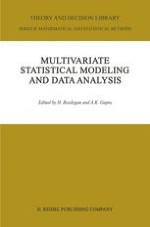This volume contains the Proceedings of the Advanced Symposium on Multivariate Modeling and Data Analysis held at the 64th Annual Heeting of the Virginia Academy of Sciences (VAS)--American Statistical Association's Vir ginia Chapter at James Madison University in Harrisonburg. Virginia during Hay 15-16. 1986. This symposium was sponsored by financial support from the Center for Advanced Studies at the University of Virginia to promote new and modern information-theoretic statist ical modeling procedures and to blend these new techniques within the classical theory. Multivariate statistical analysis has come a long way and currently it is in an evolutionary stage in the era of high-speed computation and computer technology. The Advanced Symposium was the first to address the new innovative approaches in multi variate analysis to develop modern analytical and yet practical procedures to meet the needs of researchers and the societal need of statistics. vii viii PREFACE Papers presented at the Symposium by e1l11lJinent researchers in the field were geared not Just for specialists in statistics, but an attempt has been made to achieve a well balanced and uniform coverage of different areas in multi variate modeling and data analysis. The areas covered included topics in the analysis of repeated measurements, cluster analysis, discriminant analysis, canonical cor relations, distribution theory and testing, bivariate densi ty estimation, factor analysis, principle component analysis, multidimensional scaling, multivariate linear models, nonparametric regression, etc.
